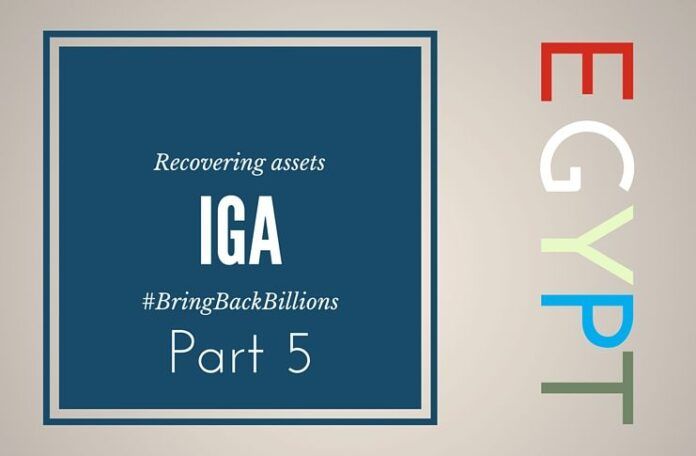
January 25th holds special significance for Egypt. It was the day on which in 1952 British troops massacred police officers in Ismailiya, a town midway along the Suez Canal. On January 25th 2011, using Social Media (especially Twitter hash #Jan25), sites for demonstration were announced and crowds started gathering at various locations. Massive crowds congregated at the Tahrir Square in Cairo, chanting against Mubarak. The demonstrators tried storming the Parliament only to be met with tear gas and water cannons. The writing was on the wall. Mubarak had to go.
The next 18 days saw frantic activity in the Mubarak household. In the knowledge his downfall was imminent, Mubarak is understood to have attempted to place his assets out of reach of potential investigators. Money was allegedly moved out of Swiss banks into tax havens. Mubarak’s wife Suzanne is half-Welsh and it is rumored that both sons of Mubarak have British Passports.
In each international asset recovery case, the Swiss judicial system determines whether it will take the verdicts from its partner at face value.
Gold bars, jewelry and other assets were attempted to be moved into Gulf countries that were friendly with the Mubarak regime.
How did the Mubaraks amass their wealth
Intelligence sources indicate that the Mubarak fortune may be most easily traced via the business dealings of Gamal Mubarak, 47. He once lived in a six-storey house in Belgravia in central London and worked in banking before setting up an investment and consulting firm in London. He resigned as a director of the company 15 years ago.
The president made his two sons the “go to” men for any companies that sought to do business in Egypt.
Kefaya, an opposition coalition that emerged before the 2005 elections to oppose the then president and his plans to transfer power to Gamal, released a lengthy investigation into nepotism, corruption and abuse of power by the ex-president and his two sons.
It said it was routine for businesses to be required to hand a cut – between 20 to 50 per cent – to Gamal or Alaa simply to set up shop. Favored entrepreneurs who worked with the brothers were given virtual monopolies in return. This is not all.
An investigative documentary broadcast by Al Jazeera titled Egypt’s Lost Power, provides new insight into how Egypt’s vast natural gas wealth was stolen through collusion by Israel and cronies of the former Egyptian dictator Hosni Mubarak.
The documentary focuses on the role of Hussein Salem, a close associate of Mubarak, and Samih Fahmy, a protege of Salem, who was installed as Egypt’s energy minister in the early 2000s.
Together with former Israeli Mossad agent Yossi Maiman they set up a company called Eastern Mediterranean Gas (EMG) that had the sole right to sell Egypt’s gas to Israel.
While internationally, gas sold for up to $12.60 per million British Thermal Units (MBTU), Egypt was selling its gas to EMG for as little as $1.50 – a scandalously low price that cost Egypt $11 billion in lost revenue.
The Israeli energy minister at the time, Yosef Paritzky, opposed the deal, telling Al Jazeera that the price Israel was paying was “too good to be true.”
The arrangement, he said, “was so covert, it was so behind the scenes, it was so un-transparent that it called for attention.” Hussein Salem, who is also known as the Father of Sharm El Sheik, a famous Egyptian resort where he owns a chain of hotels, was charged with illegally profiting from corrupt deals with Mubarak and his government. In October 2011, Salem, Khaled and daughter, Magda, were sentenced, in absentia, by an Egyptian Court to seven years in jail and a combined fine of more than US$4 billion for money laundering and profiteering.
Assem el-Gohari, the head of Egypt’s Illicit Gains Authority said at a press conference held in October 2011 that Salem, Mubarak’s closest aide, and his family own assets worth $US 4 billion in various countries which they switched into cash and deposited in banks in Hong Kong, the United Arab Emirates and other countries.
The extradition procedures between Spain to Egypt in the Salem family case are still pending. On March 11, 2016 Salem offered up to 75% of his wealth to the IGA to resolve it once and for all.
Egypt had established an organization titled Illicit Gains Authority (IGA) in the 70s which was tasked with the effort of recovering the billions stashed away by the Mubaraks and his close circle of friends. According to this podcast titled Egypt’s Hunt for Stolen Assets the IGA is still using paper as the primary medium of tracking assets which in this day and age of computers is making the process slow and inefficient.
The task is made especially difficult due to the fact that the lawyers who help stash away the assets are frequently better versed in the law than the prosecutors and judges. Till date less than a billion dollars have been confiscated by the Egyptian government. For instance, there is this one house in London, believed to be owned by Gamal Mubarak. A quick look at the ownership records shows that a company in Panama owns it. The Panama company takes its orders from a guy located in Muscat, Oman called Omar Zwali. Was the house a gift from Gamal to Omar? What did Omar get in exchange? Does the IGA have the technical nous to go after each and every one of these shell companies to get to the bottom of the matter?
Recently the IGA is taking a path of signing reconciliation agreements with the foreign businessmen that bribed Egyptian officials as well as give a way out for the Egyptian officials to make a payment and get out of the charges. There is a genuine concern in the public mind that this might give the message, “it is OK to be corrupt and you can always get out by paying a fine”.
The IGA is able to get some verdicts against Mubarak and his family but getting the Swiss to hand over the assets is an entirely different matter.
“Egyptian authorities are fixated on the idea that getting final verdicts against Mubarak is enough to get the money back, and that’s not true,” says Osama Diab, researcher at the Egyptian Initiative for Personal Rights (EIPR) who has been following the asset recovery process.
The Swiss government’s lack of confidence in Egypt’s judiciary also means that this or any verdict against Mubarak in Egypt will only be a minor development.
In each international asset recovery case, the Swiss judicial system determines whether it will take the verdicts from its partner at face value. If the Swiss deem that local trials are conducted at high enough standards for verdicts to apply in Switzerland, then a conviction for misappropriating, say, US$50 million in their home country is enough for the Swiss to hand over the $50 million. Till date the Swiss, who have about 590 million Swiss Francs ($609 million) belonging to 14 people are yet to hand it over to Egypt. The daunting tasks that an organization like IGA face are detailed in this article.
While this process of recovery plays out in the courts, the common man in Egypt continues to wait and hope… for a better tomorrow.
Click here for the next part in #BringBackBillions Part 6 – How Gadhafi looted Libya
Note:
1. Text in Blue points to additional data on the topic.
2. The conversion rate used in this post is 1 Swiss Franc = USD 1.03
- Indian Parliament’s Special Session is convened to mark the shifting to new Parliament building - September 3, 2023
- Why did Rajat Sharma of India TV not declare that Adani owns more than 16% shares in his channel? - January 29, 2023
- Prannoy Roy to get Rs.605 crore from Adani as per Stock Exchange filing. Why is Income Tax not acting on Roys’ dues of over Rs.800 crore? - January 4, 2023










